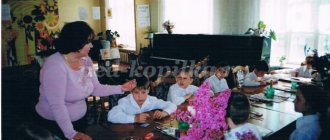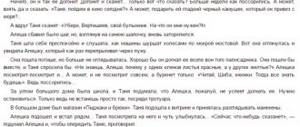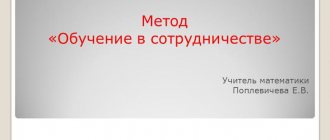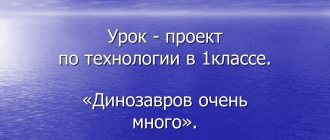Creating a problem situation in mathematics lessons.
A student from the class names some value of X. A student at the blackboard enters this number into the table and, putting it into a formula, finds and enters the corresponding value Y into the table. Then another student from the class names another value of X and the student at the blackboard does the same same operations.
The class's task is to “guess” the formula written on the card. A problematic situation has been created. The student who names the formula first wins. Example No. 2.7 class. Topic: “Abbreviated multiplication formulas”
The criminals stole a large amount of money from the bank. They were caught, but the stolen amount could not be determined. The criminals categorically refuse to name it, claiming that they wrote down this number as a degree and encrypted not only the base, but also its exponent. The experts managed to find out the basis of the degree. This number is 597. But they don’t say what the figure was. After another interrogation, the criminals said that the exponent is the root of the equation
( 2y +1)2 – 4y2 =9
y=2
5972 = (600 – 3)2 =6002 -2 x 600 x 3 + 32 = 360000 – 3600 + 9 =356409
Example No. 3. A long time ago, even before our era, in Ancient Greece, one ruler asked Euclid the question: “How long does it take to learn mathematics?” To this the scientist replied that it would take not a year, not two, but a lifetime. The ruler exclaimed: “But I am not an ordinary mortal, but a king!” And then Euclid uttered one of his famous phrases. He said: “There is no royal path to mathematics!” So, there is no royal, quick way to mathematics. But there is another way by which you can comprehend this science throughout your life. You have been studying mathematics for several years. Do you feel like you are wandering aimlessly? Do you have a goal for today's lesson? Or the famous legend about the creator of chess, etc.
Example No. 4. Solve the equation in whole numbers. 28k + 30n + 31m = 365
Teacher's words: Who saw? Who guessed? Who decided?
“Looking does not mean seeing!”
Answer: 365 is the number of days in a year, 28 is the number of days in February, 30 is the number of days there are 4 months in a year, 31 is the number of days there are 7 months in a year. Then: 28 •1 + 30 • 4 + 31 • 7 = 365.
Example No. 5. Before deriving the formula for the sum of n terms of a geometric progression, schoolchildren are offered, for example, the following life situation.
One day a stranger knocked on the window of a rich merchant and offered the following deal: “I will bring you 100,000 rubles every day for 30 days.” And you gave me 100,000 rubles on the first day. you will give 1 kop., on the second day for 100,000 rubles. – 2 kopecks. and so every day you will increase the previous amount of money by 2 times. If the deal is profitable for you, then we’ll start tomorrow.”
The merchant was delighted with such luck. He calculated that in 30 days he would receive 3,000,000 rubles from a stranger. The next day we went to the notary and legalized the deal.
A problematic situation is created. Who lost in this deal: the merchant or the stranger?
3. Creating problematic situations through solving problems related to life.
Example No. 1. 5 grades Topic "Perimeter of a rectangle"
Dima's family moved to a new house in the summer. They were given a rectangular plot of land. Dad decided to put up a fence. He asked Dima to count how many picket fences would be needed for a fence, if 1 linear meter of fence requires 10 pieces? How much money will the family spend if each ten costs 50 rubles?
Problem situation: you need to find the length of the fence (perimeter of the rectangle).
Example No. 2. 5 grades Topic "Interest"
You know that this year I was awarded the Presidential Prize for excellence in teaching. Of course, this is your merit. Thank you. The amount of the bonus is 100 thousand rubles. But I won't get all the money. Income tax is deducted at 13%. I want you to help me calculate how much I will receive.
Question: “How can we help you if we don’t know what percentage is?”
A problematic situation has been created. The children work with pleasure throughout the lesson. At the end of the lesson, complete the task to the end.
4.Creating problem situations through performing practical tasks.
Example No. 1.5 grade. Topic: "Area of a Rectangle".
During the technology lesson, Seryozha cut with a jigsaw and got various leftover plywood. Which remnant wastes the most plywood?
Problematic situation. We need to find the area of this figure.
Conclusion: divide the figure into rectangles, find the area of each part and fold (one of the options)
. Example No. 2. 5 grades Theme "Area of a square"
For the lesson, you were given the task of gluing together 1 m2 of newspaper. You did it? Well done. Let's see how many people can fit on it. We find out that there are 4 people. Do you think it is possible on a square area with a side of 30 km? fit the entire world population? (6.5 billion)
Problem situation: you need to find the area of the site (area of the square)
Example No. 3. 6th grade Topic "Coordinate plane"
At the stage of active and conscious assimilation of new material, as well as at the consolidation stage, I use practical works “Animals on a plane”, “Astronomy and the coordinate plane”. The guys build points according to coordinates and draw animals and constellations, then talk about them. They also perform creative work, offer their own drawings and make up assignments based on them.
Example No. 4. Topic: “Sum of the angles of a triangle.” Construct a triangle if its angles are equal to a) 30◦, 50◦ and 100◦. b) 40◦,70◦ and 80◦. (impossible task)
Example No. 5. topic "Pythagorean Theorem". The following task can serve as a motivating (initial) task: “To secure the mast, you need to install 4 cables. One end of each hummock should be fixed at a height of 12 m, the other on the ground at a distance of 5 m from the mast. Is 50 m enough to attach the mast? Analyzing the mathematical model of this practical problem, students formulate a problem - they need to find the hypotenuse of a right triangle using two known legs.
5. Creation of problem situations through solving attention and comparison problems.
Example No. 1 The teacher gave third-grader Dasha the task of counting how many triangles are shown in the picture. She found 5 triangles. Lena came up and found 7 triangles. Which one is right? Let's try to count together.
2. What do these figures have in common, and what are the differences?
6.Creation of problematic situations through the contradiction of new material to old, already known.
Example No. 1. 7th grade Topic “Abbreviated multiplication formulas”
We calculate (2 x 5)²= 2² x5² = 100
(3 x 4)²= 3² x 4² = 9 x 16 = 144
(5 : 6)² = 5² : 6² = 25 : 36
(3 + 4)² = 3² + 4² = 9 + 16 = 25 Try counting differently.
( 3 + 4)² =7² = 49
A problematic situation has been created. Why different results?
( 3 +4)² ≠ 3² + 4²
Example No. 2. Algebra lesson in 8th grade on the topic “Quadratic inequalities.” At the stage of updating students’ knowledge during the successful completion of a task on solving linear inequalities, they came across something incomprehensible, new, signaling that something was wrong:
^ Linear inequalities:
Quadratic inequalities:
A problematic situation stimulates children to develop an independent search for a solution, because they have just been successful.
Among the solutions, children can choose the help of a teacher or turn to the textbook.
7. Creating problem situations through different ways of solving one problem.
Example No. 1. 7th grade Topic: Problem Solving
There are two tanks at the gas station in the village of Vsekhsvyatskoe. At the beginning of the sowing season, both tanks are full. There were 59 tons of gasoline in 1, and 44 tons in 2. After how many days will the same amount of fuel remain in the tanks if 5 tons are consumed daily from tank 1, and 2 tons from tank 2?
Solve using an equation (algebraic)
59 – 5x = 44 – 2x
But yesterday, fourth-grader Stas, who does not know how to solve such equations, was also able to solve it.
Problem situation: what method did he propose (arithmetic)
Example No. 2. "Distributive Law". An example is given: 2.83•34.6+2.83•65.4 suggest who will decide faster, the teacher (using the distributive law) or the students based on actions.
8. Creating problem situations through small research tasks.
5 grades Theme "Circumference"
Even the ancient Greeks found the circumference of a circle using the formula C=P•d D is the diameter of the circle.
Question: what is p?
We work in pairs, performing the necessary measurements.
1. Wrap a thread around the glass, straighten the thread, the length of the thread is approximately equal to the circumference of the glass. To get a more accurate result, you need to do this several times. Enter your data into the following table.
2.Measure the diameter of the glass with a ruler. Enter the data into the table.
3.Find the value of P as an unknown factor. You can use a calculator.
4. For each pair, enter the calculated value of P in the table on the board. P is an infinite fraction; modern machines can determine up to a million decimal places.
Used Books.
1. Problem-based learning in mathematics lessons: From the work experience of A. L. Lisitsyna, a mathematics teacher at the Municipal Educational Institution “Secondary School No. 3”, Obluchye. –Birobidzhan: Regional IPKPR, 2011. – 24 p.
2. Melnikova E.L. Problem lesson, or How to discover knowledge with students: A manual for teachers. – M., 2006.
3. Radaeva Ch.F. Using problem situations in the classroom as a way to develop learning skills // Psychology, Sociology and Pedagogy. – December 2012. – No. 12 [Electronic resource]. URL: https://psychology.snauka.ru/2012/12/1473 4. Makhmutov M.I. “Problem-based learning” M. “Pedagogy”, 1975.
5.Zotov Yu.B. “Organization of a modern lesson” M. “Prosveshcheniye”, 1984
6. Babansky Yu. K. Problem-based learning as a means of increasing the effectiveness of schoolchildren’s learning. — Rostov-on-Don, 1970.
Problem situations in lessons in elementary school, an article on the topic
Prepared by: Terentyeva M.P.
IMPLEMENTATION OF THE ACTIVITY METHOD BY CREATING PROBLEM SITUATIONS IN LESSONS IN PRIMARY SCHOOL
The transition to an updated system of primary education requires the modern teacher to be able to help the student discover new knowledge himself, and not give new material in a ready-made form. In this regard, there is a need to use new educational technologies in the educational process, which involve student research activities in the classroom. One such technology is problem-based learning.
A problematic situation in teaching is a planned, specially conceived means aimed at awakening students’ interest in the topic under discussion. Problem situations are based on active cognitive activity, consisting in searching and solving complex issues that require updating knowledge, analysis, the ability to see patterns behind individual facts, etc.
Unlike the traditional one, a problem lesson is characterized by creative, rather than reproductive, activity of students, which ensures a deeper assimilation of knowledge, development of intelligence and creativity, nurturing an active position, without causing overload. For the kids, this is truly “learning with passion,” which significantly reduces nervous stress.
(In the structure of an activity lesson, the stages “Updating and recording an individual difficulty in a trial educational action” (2) “Identifying the place and cause of the difficulty” (3) “Building a project for overcoming the difficulty” (4) involve the creation of a problem situation)
I would like to introduce you to the techniques proposed by Elena Leonidovna Melnikova, Candidate of Psychological Sciences, Associate Professor of the Department of Primary and Preschool Education.
1. Classic. These include:
- creating a problematic situation with surprise. Children are simultaneously presented with contradictory facts, different points of view, and different opinions of students are confronted with a question or practical task.
- a problematic situation with difficulty. Its meaning is to give a practical task that is not feasible at all, to give a task that is not similar to the previous one, or to give an impossible task that is similar to the previous one.
2. Abbreviated:
- stimulating dialogue, the meaning of which is to ask a problem, difficulty, to help formulate a learning task. Used to encourage the creation of a contradiction, to encourage the formulation of a problem.
- leading problematic dialogue. This is a logically constructed chain of questions and tasks that step by step lead the student to create a lesson topic.
3. Motivating. I use the following techniques:
- communicating the topic of the lesson using the “bright spot” technique.
The essence of the technique is to communicate interesting, intriguing material: fairy tales, legends, excerpts from fiction.
— demonstration of incomprehensible phenomena using clarity and experiment.
- communicating the topic of the lesson using the “updating” technique. The point is to discover the meaning of the significance of the problem for students.
Basic techniques for creating problem situations
- Bringing schoolchildren to a contradiction that causes them surprise or difficulty.
This path exactly repeats the link in posing the problem in real scientific creativity. However, this is precisely how students’ creative ability to independently recognize a contradiction and formulate a problem is formed.
Fragment of a Russian language lesson in 4th grade.
Topic: Declension of nouns.
In the sentence “The old woman was worried about her sister and daughter,” I propose to find the nouns (sister, daughter), then determine the gender and case, (F. r., P. p.), highlight the endings. Having identified the endings, children are surprised and a problematic situation arises: Nouns are of the same gender and case, but their endings are different.
The question arises: Why do nouns of the same gender and case have different endings?
(Next, children express their assumptions that nouns of the same gender may have different case endings, which means that some more knowledge about the noun is needed, make generalizations and conclusions, and offer various options for solving the problem).
- Colliding contradictions between theoretical knowledge and practical activities.
Children are asked to complete a practical task, for which the children do not have enough knowledge and need to learn and study something new. Such tasks stimulate cognitive activity; children understand that they can only be completed after certain theoretical preparation.
Fragment of a math lesson
When studying a new unit of measurement for the area of figures - the square decimeter, a task is proposed: find out the area of the table top if its length is 90 cm and width is 50 cm.
(Knowing the formula for finding area, children try to multiply the length by the width. A difficulty arises, since the children have not yet studied the multiplication of two-digit numbers. It is proposed to study the multiplication of a two-digit number by a two-digit number, but then we must deviate from the topic of the lesson. Then we come to the conclusion that it is necessary another unit of area measurement)
Children are given a task that is obviously impossible to complete. Having applied theoretical knowledge, children understand that the task cannot be completed in the form in which it was proposed and it is necessary to either change it or supplement it with new data.
For example: fold a rectangle from strips 4 cm, 6 cm, 6 cm, 3 cm long.
(Students conclude, based on their knowledge of the properties of a rectangle, that the task is impossible. It is necessary to change one of the sides to choose from).
The contradiction between theoretical knowledge and practical activity leads to a problematic situation, and ultimately to the activation of cognitive activity.
- Statement of specific problematic issues that require logic of reasoning, justification, generalization, and specification.
Problematic issues are an impetus for productive thinking aimed at understanding the material being studied, overcoming the mechanical assimilation of knowledge, and applying knowledge in practical activities.
Problematic questions in natural history:
- On which planet of the solar system is New Year celebrated 4 times more often than on Earth and why?
- Will algae and moles be able to exist on Earth if the Sun disappears?
- Why do beautifully flowering and useful plants suffer the most in nature?
- What happens if the plants disappear?
- Why are low-growing blueberries called shrubs, and tall elecampane grass?
- If you cut off all the stems of a bush except one, will it become a tree?
- Is it possible to detain migratory birds if you hang insulated bird houses everywhere?
- People often change their apartments, move from house to house, from floor to floor. Can forest animals switch apartments? etc.
Problematic questions in the Russian language:
- Are the following words related (same root):
Breath, spiritual, breathe, air, sigh, inhale, inspiration, soul, darling? Country, wanderer, strange, wandering, side, space, spacious? Earth, earthly, earthy, earthy, earthy, countryman, strawberry, digger? Holiday, festive, idle, idleness, abolish, celebrate, celebration? and etc.
When working with such words, a large number of questions arise. Children cannot immediately answer the question posed; they have to turn to dictionaries and reference books, which develops independence and learning activity.
- What unites the written words? Which one is “extra”?
Prefix, root, suffix, ending
(suffix, since all other words are ambiguous) Corn, tulle, shampoo. (Callus is a feminine noun, the rest are masculine)
- Statement of problematic tasks.
According to mathematics it could be
a) tasks with insufficient or redundant initial data. Such tasks are useful for developing the ability to carefully study the text of a task and analyze it for the necessity and sufficiency of data.
There are 10 oranges in a vase. Dunno ate 3 oranges, Gunka ate 4 oranges. How many oranges did they eat together?
- Which number in the problem was not needed to solve? Why?
- so that this number is required.
The cyclist was traveling at a speed of 12 km/h. How many kilometers did he travel? (Insufficient data; the length of time the cyclist was on the road is not indicated).
tasks where there is no question:
Solve the problem: The monkey picked 9 bananas. She ate 3 bananas.
(Children notice that there is nothing to solve, since there is no question in the task. I suggest that they pose the question themselves and solve it. In more complex problems, children offer various questions, and several problems are obtained under one condition).
b). Problems with known mistakes.
— You can use this technique: help some fairy-tale hero or character find and correct errors in the solution or check how he completed the task. Children love to act as a teacher checking work. This technique develops attention and activates the mental activity of students.
— You can offer to “find errors” in tasks that were completed correctly. To analyze the finished solution, children must first solve the problem correctly themselves. After analyzing and comparing, they come to the conclusion that the decision is correct. But it happens that the child himself makes a mistake. A problematic situation arises. Then the class or teacher comes to the rescue.
— Another technique: give the correct solution to the same problem in several different ways and ask students to find the “correct” solution. Children have to analyze different ways to solve a problem, prove that all options are correct, and choose the most accessible or rational one.
V). Problems with conflicting data.
- There are 10 apples and 6 pears on the table. How many oranges are there on the table?
- There were 32 people on the bus. At the stop, 9 people got off and 14 got on the bus. How many kilometers did the bus travel in 2 hours?
(Children note that the question does not meet the conditions, formulate their own and solve the resulting problem)
G). Non-standard task texts.
Non-standard texts of problems activate attention, make the process of solving problems interesting and exciting, which also contributes to the activation of cognitive activity. Children are of great interest in solving problems from the “Problem Book” by G. Oster.
d). Creative tasks.
These are tasks for which it is necessary to find a new solution algorithm.
- Carrying out problematic theoretical and practical tasks.
One of the means of creating a problematic situation in the educational process is to perform problematic theoretical and practical educational tasks. I widely use this technique in science lessons.
Tasks that begin with the words: prove, define, observe, consider, compare, think, research, comment, suggest, etc.
- Comment on the statement: “The ability to speak is the main difference between humans and animals”
- Determine what a butterfly has in common with a stone and how they differ? etc.
- Consideration of phenomena, actions, situations from different positions and points of view.
This technique can be widely used in reading and speech development lessons. Children are asked to evaluate the actions of the heroes of a literary work from the position of the author, reader, literary critic, optimist, pessimist, hero or character of the work (even inanimate). This technique allows you to comprehend the work, think about its idea, the author’s intention, express and defend your point of view. Opinions can be the most controversial, but a necessary condition is to defend and argue your point of view.
- Leading or encouraging dialogue.
Staying in a problematic dialogue allows its participants to develop the ability to listen and hear the interlocutor, to express a certain moral position. A positive result is undoubtedly that in lessons children are not passive listeners, but are highly active in the learning process.
Dialogue leading up to the topic
is a system of questions and tasks that ensure that students formulate the topic of the lesson. Questions and assignments may vary in nature and degree of difficulty, but should be feasible for students. The last question contains a generalization and allows students to formulate the topic of the lesson. As the dialogue progresses, even the students’ erroneous answers must be accepted.
Example: Russian language lesson in 4th grade on the topic “Soft sign after hissing feminine nouns at the end”
| ANALYSIS | TEACHER | STUDENTS | |
| Formulation of the problem | Dialogue leading to the topic. | -Look at the two columns of words on the board | On the desk: ball daughter hut oven reed mouse |
| -What do you notice in common? | -In each column there are nouns that end in a sibilant consonant. | ||
| -What is the difference? | In the first column, nouns are written without a soft sign, and in the second column - with a soft sign at the end of the word. | ||
| Subject | -So, what will be the topic of today’s lesson? (Fixes the topic). | A soft sign after sibilants at the end of nouns. | |
Dialogue motivating a problematic situation
is a combination of the technique of creating a problem situation and special questions that stimulate students to recognize the contradiction and formulate a learning problem.
Lesson on the surrounding world in 2nd grade on the topic “Earth in space.”
| ANALYSIS | TEACHER | STUDENTS | |
| Formulation of the problem | Presenting conflicting opinions | -Look carefully at the two pictures in the textbook. Read their captions | Examine the illustrations: “The World according to Ptolemy”, “The World according to Copernicus” (PROBLEM SITUATION) |
| Encouraging Awareness | -What surprised you? What interesting things did you notice? | Ptolemy thinks that the Sun revolves around the Earth, and Copernicus thinks that the Earth revolves around the Sun. (AWARE OF CONTRADITION) | |
| Motivation to the problem | -What question arises? | -Which scientist is right? (QUESTION) | |
| Question | Fixes on the board | ||
Message topic with a motivating technique.
The essence of the method is that the teacher precedes the message of the finished topic either with intriguing material (the “bright spot” technique) or with a description of the significance of the topic for the students themselves (the “relevance” technique). In some cases, both motivating techniques are used simultaneously.
Example: Russian language lesson in 4th grade on the topic “Dative case”
| ANALYSIS | TEACHER | STUDENTS | |
| Formulation of the problem | “Bright Spot” in the form of a comic poem | -Today we will get acquainted with the case about which Lezhebokin, the hero of G. Graubin’s poem, said this: A case like….. I can't stand it since childhood. Giving, sharing anything I don't like it with friends. | |
| -Who guessed which case we are talking about? | -About the dative | ||
| Subject | -So, the topic of our lesson? (Fixes the topic on the board) | -Dative | |
The main value of creating problem situations in the classroom is that children once again have the opportunity to compare, observe, and draw conclusions; They are convinced that not every question has a ready answer, that the answer may be ambiguous, that each of them has every right to seek and find their own answer, to defend their opinion. The teacher’s task is not to fish out the appropriate answer from the masses, but to see a living thought in every child’s opinion. Presenting problematic situations to a child leads to the fact that he is not afraid of problems, but strives to solve them. And I really want to hope that, upon entering life, the child will be protected from stress.





